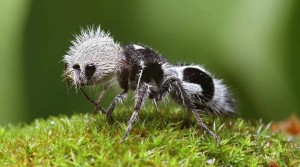Meet the “Panda Ant”. Well, it’s not really an ant at all. It’s actually a wingless wasp! It’s related to the Velvet wasps of the family Mutillidae, and are known as, “Cow Killers”. No, they don’t really kill cows but they do have a horrible sting. Just like in bees and hornets, their stinger is actually a modified egg depositor.
A common trait among velvet ants is that they are well, velvety. They are known for being quite hairy and they have some of the hardest exoskeletons in the wasp family.
Panda ants are solitary which means they don’t live in nests or communities. The females crawl around feeding primarily on nectar but they will take advantage of an occasional smaller ant, caterpillar, or an unguarded pupae/larvae. The males feed primarily on nectar.
The males are much larger than the females in the Mutillidae family and colourisation patterns can vary greatly in many species. The male Panda ant, however, looks somewhat similar to the females. The female’s colour probably helps the males identify her as he flies overhead. Once the male spots her, he lifts her into the air to mate. After mating, she goes underground, usually burrowing into a ground bee or wasp nest. She then lays her eggs on each pupa in the nest. The larvae then feed on their hosts. She can lay up to 2000 eggs within her 2-year lifecycle.
source: amazinglife.bio
Ask me anything
Explore related questions





